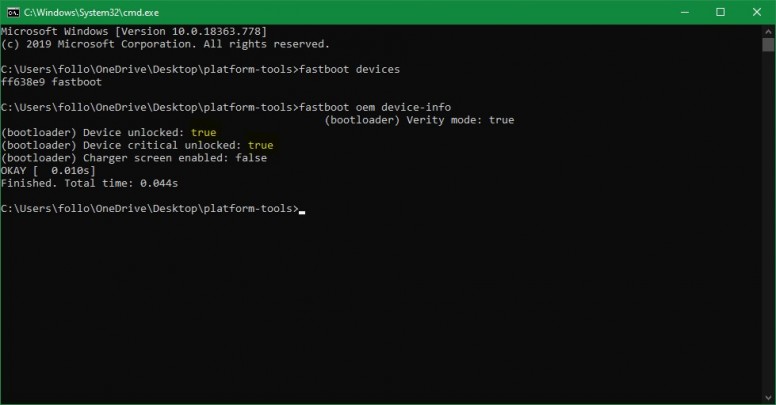

- #Fastboot devices not showing my device install
- #Fastboot devices not showing my device drivers
- #Fastboot devices not showing my device windows 10
- #Fastboot devices not showing my device android
- #Fastboot devices not showing my device pro
In case you are getting ‘adb or fastboot command not found error’ on Mac, read my tutorial to solve the issue.
In case you are trying to flash an OTA update.zip, a factory image, or a custom recovery image (twrp.img, for instance), make sure you have saved the files to flash in the ‘ platform-tools‘ folder along with ‘adb.exe’, ‘fastboot.exe’, etc. That’s to say, you haven’t set the correct path under User variables or System variables. 
#Fastboot devices not showing my device windows 10
You haven’t set up system-wide ADB and Fastboot on your Windows 10 PC. If you are trying to run ADB command from a location where ‘adb.exe’ and ‘fastboot.exe’ are not present. #Fastboot devices not showing my device android
Installing the latest Android SDK Platform-tools on your PC might fix the problem. You may also get the “ADB command not found” error if you have an outdated version of ADB and Fastboot drivers.
#Fastboot devices not showing my device drivers
The reality is, you must download and set up the ADB and Fastboot drivers additionally.
Many people think that ADB and Fastboot are present on their Windows PC by default. So, if you’re getting the “adb is not recognized as an internal or external command” error in the cmd window, it could be due to one of the following reasons. ‘fastboot’ is not recognized as an internal or external command, operable program or batch file. It logs the device, commands and their responses.ADB : The term ‘adb’ is not recognized as the name of a cmdlet, function, script file, or operable program. View a log of commands executed by ADB Master. Future features will enhance this section with the use of filters and colors. View live Logcat data from all selected devices in one list making it easy to monitor multiple devices at the same time. Future features include the ability to terminate processes and use custom top commands. It lists all selected devices in one view making it easy to monitor multiple devices at the same time. This section uses the command “adb shell top -m 20” to list the top 20 processes running on the device. Red: Installed on some or all devices but is disabled on all installed instances Orange: Installed on some or all devices, but is disabled on one or more Black: Installed and enabled on some selected devices Green: Installed and enabled on all selected devices Uninstall multiple apps on all selected devices with one click. This section allows you to compare and manage applications (packages) on all selected devices. View the results of the command in the “ADB Log” tab. NOTE: This function treats spaces as command separators so it may not work for all possible adb commands at the moment. Execute any custom ADB command in the ADB Command box and hit enter or press “Execute” to run that command on all selected devices. “Identify” a device installs and runs a small utility to wake the device and display the same information that appears in the device list as well as the IP address. Press power, back, home or volume up and down buttons on all selected devices at the same time. Shutdown, reboot, reboot to recovery or reboot to bootloader by selecting the devices and then pressing the desired button. This section allows you to perform actions or commands on all selected devices. This will uninstall “Helper.apk” and set the device back to USB mode. WiFi connected devices which has a button to switch the selected devices to USB mode. #Fastboot devices not showing my device install
This will install “Helper.apk” to display adb state on the device and enable the device to be discovered by ADB Master.

USB connected devices with a button to switch the selected devices to WiFi (tcpip) mode. These lists provide a way to list and select devices to work with. The background will turn green when the correct folder is selected.ĥ) For the Android devices to appear in the list, enable "USB Debugging" and connect them to the computer with USB.Ħ) Select one or more devices from the list of USB or WiFi connected devices to perform actions or view information on them.Īt the top of the application are the device lists. Mac users: If you get an error that the jar file is corrupt or cannot be opened, try right clicking it and select open at least once to allow the unsigned jar to run.Ĥ) Set the ADB location in the “Control” tab of ADB Master by browsing to the folder containing “adb”.
#Fastboot devices not showing my device pro
Please consider buying the pro version if you use this tool.Ģ) After installing the app, copy the exported ADB Master folder from your Android's SD card to the computer.ģ) In the 'ADB-Master' folder run the 'ADB-Master.jar' file by double clicking (requires Java to be installed). One click to switch adb to wireless, perform actions, commands or view and compare installed apps, running processes with cpu usage or browse logcat data for multiple selected devices… At the same time. Manage and monitor multiple Android devices using ADB (Android debug bridge).







 0 kommentar(er)
0 kommentar(er)
